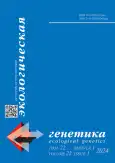CRISPR/Cas editing of a CPC gene in Arabidopsis thaliana
- Authors: Khusnutdinov E.A.1, Panfilova M.A.1,2, Terekhov M.P.1, Mikhaylova E.V.1,2
-
Affiliations:
- Ufa Federal Research Center of the Russian Academy of Sciences
- Ufa State Petroleum University
- Issue: Vol 22, No 1 (2024)
- Pages: 13-22
- Section: Genetic basis of ecosystems evolution
- URL: https://journals.rcsi.science/ecolgenet/article/view/256747
- DOI: https://doi.org/10.17816/ecogen624373
- ID: 256747
Cite item
Abstract
BACKGROUND: Identification of target genes responsible for visible phenotypic effect may contribute to the development of transgene-free bioengineering strategies and application of crop varieties with edited genome. CAPRICE (CPC) is a single-repeat R3 MYB transcription factor, involved in anthocyanin biosynthesis and trichome formation. It is assumed that CPC controls the expression of Dihydroflavonol-4-reductase (DFR), a key gene of anthocyanin biosynthesis.
AIM: The aim of the study was to determine whether knockout of the CPC gene using CRISPR/Cas9 results in visible anthocyanin accumulation.
MATERIALS AND METHODS: Three guide RNAs were designed to excise a MYB domain from the CPC gene of Arabidopsis thaliana. Anthocyanin content and expression of CPC and DFR genes were studied in edited plants.
RESULTS: The expected 662 bp deletion was detected in 2,7% of glufosinate-resistant plants, however none of the mutations were homozygous. Four edited lines were studied in four generations. An upregulation of the DFR gene was observed in edited lines, however CPC gene expression, anthocyanin content and trichome development were not significantly different from those in control plants. Moreover, in A. thaliana pigmentation did not directly depend on DFR or CPC gene expression.
CONCLUSIONS: Our results suggest that CPC gene is involved in regulation of DFR gene expression and anthocyanin biosynthesis pathway, however in case of mutations plants might utilize other transcription factors to maintain homeostasis. Therefore, CPC gene is not a suitable target for CRISPR/Cas studies in Arabidopsis.
Keywords
Full Text
##article.viewOnOriginalSite##About the authors
Emil A. Khusnutdinov
Ufa Federal Research Center of the Russian Academy of Sciences
Email: emil.khusnutdinov.18@bk.ru
ORCID iD: 0000-0001-6626-3928
PhD student, junior researcher, Institute of biochemistry and genetics
Russian Federation, 71 Oktyabrya av., Ufa, 450054Maria A. Panfilova
Ufa Federal Research Center of the Russian Academy of Sciences; Ufa State Petroleum University
Email: masha.panfi@yandex.ru
ORCID iD: 0000-0003-0594-2630
PhD student, junior researcher
Russian Federation, 71 Oktyabrya av., Ufa, 450054; UfaMikhail P. Terekhov
Ufa Federal Research Center of the Russian Academy of Sciences
Email: morganm2007@yandex.ru
ORCID iD: 0009-0006-4549-7470
Russian Federation, 71 Oktyabrya av., Ufa, 450054
Elena V. Mikhaylova
Ufa Federal Research Center of the Russian Academy of Sciences; Ufa State Petroleum University
Author for correspondence.
Email: mikhele@list.ru
ORCID iD: 0000-0001-7374-8405
SPIN-code: 2961-1658
Scopus Author ID: 55822733800
ResearcherId: C-2551-2017
Cand. Sci. (Biol.), Senior Researcher
Russian Federation, 71 Oktyabrya av., Ufa, 450054; UfaReferences
- Bogatyreva NV, Sokolov AY, Moiseeva YM, et al. Regulatory status of genome-editing plants: perspectives for Russian Federation. Ecological genetics. 2021;19(1):89–101. EDN: AONFMG doi: 10.17816/ecogen42532
- Khusnutdinov E, Sukhareva A, Panfilova M, Mikhaylova E. Anthocyanin biosynthesis genes as model genes for genome editing in plants. Int J Mol Sci. 2021;22(16):8752. doi: 10.3390/ijms22168752
- Kirik V, Simon M, Huelskamp M, Schiefelbein J. The ENHANCER OF TRY AND CPC1 gene acts redundantly with TRIPTYCHON and CAPRICE in trichome and root hair cell patterning in Arabidopsis. Dev Biol. 2004;268(2):506–513. doi: 10.1016/j.ydbio.2003.12.037
- Nemie-Feyissa D, Olafsdottir SM, Heidari B, Lillo C. Nitrogen depletion and small R3-MYB transcription factors affecting anthocyanin accumulation in Arabidopsis leaves. Phytochemistry. 2014;98:34–40. doi: 10.1016/j.phytochem.2013.12.006
- Dugassa N, Feyissa TL, Kristine MO, et al. The endogenous GL3, but not EGL3, gene is necessary for anthocyanin accumulation as induced by nitrogen depletion in Arabidopsis rosette stage leaves. Planta. 2009;230:747–754. doi: 10.1007/s00425-009-0978-3
- Zhu H-F, Fitzsimmons K, Khandelwaland A, Kranz RG. CPC, a single-repeat R3 MYB, is a negative regulator of anthocyanin biosynthesis in Arabidopsis. Mol Plant. 2009;2(4):790–802. doi: 10.1093/mp/ssp030
- Xing H-L, Dong L, Wang Z-P, et al. A CRISPR/Cas9 toolkit for multiplex genome editing in plants. BMC Plant Biol. 2014;14:327. doi: 10.1186/s12870–014–0327-y
- Mikhaylova E, Khusnutdinov E, Shein M, et al. Transcription factor Caprice as a target to induce anthocyanin biosynthesis in oilseed rape. AIP Conf Proc. 2021;2388:030024. doi: 10.1063/5.0068528
- Haeussler M, Schönig K, Eckert H, et al. Evaluation of off-target and on-target scoring algorithms and integration into the guide RNA selection tool CRISPOR. Genome Biol. 2016;17(1):148. doi: 10.1186/s13059-016-1012-2
- Cermak T, Curtin SJ, Gil-Humanes J, et al. A multipurpose toolkit to enable advanced genome engineering in plants. Plant Cell. 2017;29(6):1196–1217. doi: 10.1105/tpc.16.00922
- Clough SJ, Bent AF. Floral dip: a simplified method for Agrobacterium-mediated transformation of Arabidopsis thaliana. Plant J. 1998;16(6):735–743. doi: 10.1046/j.1365-313x.1998.00343.x
- Porebski S, Bailey LG, Baum BR. Modification of a CTAB DNA extraction protocol for plants containing high polysaccharide and polyphenol components. Plant Mol Biol Rep. 1997;15:8–15. doi: 10.1007/BF02772108
- Livak KJ, Schmittgen TD. Analysis of relative gene expression data using real-time quantitative PCR and the 2–∆∆CT method. Methods. 2001;25(4):402–408. doi: 10.1006/meth.2001.1262
- Lee J, Durst RW, Wrolstad RE. Determination of total monomeric anthocyanin pigment content of fruit juices, beverages, natural colorants, and wines by the ph differential method: collaborative study. J AOAC Int. 2005;88(5):1269–1278. doi: 10.1093/jaoac/88.5.1269
- Wang Z-P, Xing H-L, Dong L, et al. Egg cell-specific promoter-controlled CRISPR/Cas9 efficiently generates homozygous mutants for multiple target genes in Arabidopsis in a single generation. Genome Biol. 2015;16:144. doi: 10.1186/s13059-015-0715-0
- Wang X, Chen W, Yao J, et al. The evolution and expression profiles of EC1 gene family during development in cotton. Genes. 2021;12(12):2001. doi: 10.3390/genes12122001
- Khusnutdinov E, Artyukhin A, Sharifyanova Y, Mikhaylova EV. A mutation in the MYBL2–1 gene is associated with purple pigmentation in Brassica oleracea. Int J Mol Sci. 2022;23(19):11865. doi: 10.3390/ijms231911865
- El-Brolosy MA, Stainier DYR. Genetic compensation: A phenomenon in search of mechanisms. PLoS genetics. 2017;13(7):e1006780. doi: 10.1371/journal.pgen.1006780
- Shoeva OYu, Glagoleva AYu, Khlestkina EK. The factors affecting the evolution of the anthocyanin biosynthesis pathway genes in monocot and dicot plant species. BMC Plant Biol. 2017;17:256. doi: 10.1186/s12870-017-1190-4
Supplementary files








